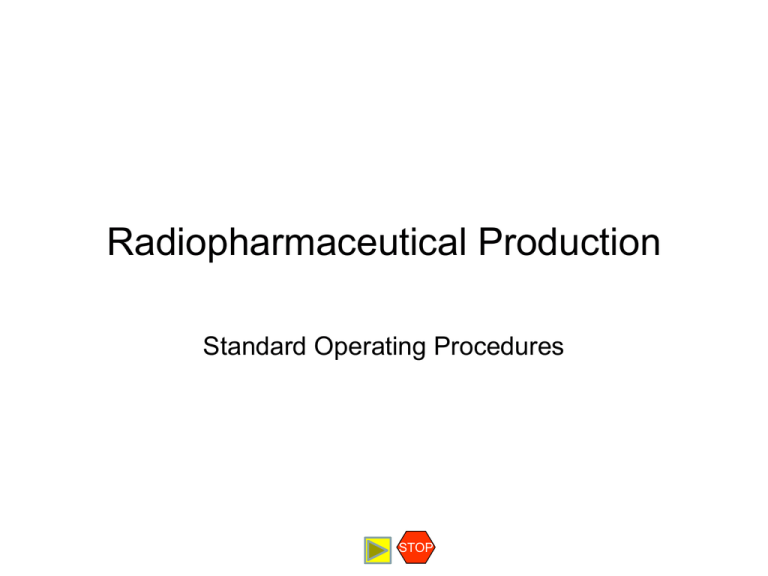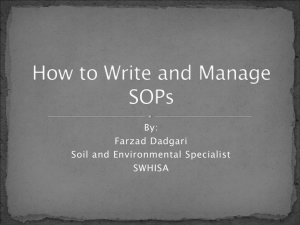SOPs
advertisement

Radiopharmaceutical Production Standard Operating Procedures STOP Standard Operating Procedures • • • Although useful reference documents for inspectors, Standard Operating Procedures (SOPs) are written for the benefit of the persons carrying out the operation in question. They should be written so that the user can easily understand them. If possible, they should be written by or with the operators, to ensure that they accurately reflect what happens in practice. They will be written by the department responsible for carrying them out, but should also be approved by the QA department, if appropriate. Contents • General Principles • SOP Authorship • SOP Format • Where are SOPs needed? • Example SOPs STOP General Principles Radiopharmaceutical Production Standard Operating Procedures Contents General Principles SOP Authorship SOP Format • • • • Where are SOPs needed? Example SOPs • STOP Who is responsible for preparing SOPs? - they should be written by or with the operators, to ensure that they accurately reflect what happens in practice. What is the format for an SOP? – There should be a consistent format used for all SOPs Which activities require SOPs? - Nearly all activities require an SOP. Where should SOPs be stored? - Master copies of procedures should be stored by the responsible department or centralized in the document control department. Authorized copies of each procedure should be stored adjacent to the place where the operation will be carried out, as a reference document that can be consulted at will. Are SOPs associated with records? - All critical equipment should have logbooks in which maintenance and cleaning are recorded. A record should also be kept of the use of this equipment. The procedures for sanitation should include methods, equipment, materials, responsibilities and the schedule for carrying them out. SOP Authorship Radiopharmaceutical Production • Standard Operating Procedures Contents General Principles SOP Authorship SOP Format Where are SOPs needed? Example SOPs STOP • The author of the SOP should be someone who is very familiar with the procedure being performed. If someone else writes the SOP, the knowledgeable person should be close communication with the author and have the opportunity to review and revise the procedure before it becomes official. The best procedure is to have all the people who perform the procedure discuss the SOP and make comments. Then the author takes these comments and incorporates them into the SOP SOP Format Radiopharmaceutical Production Standard Operating Procedures Contents General Principles SOP Authorship SOP Format Where are SOPs needed? Example SOPs STOP The following are suggested contents for the SOP. On the following slide is a description of the sections that could be included in the SOP. Header/Footer: The standard format is a Header with the SOP’s title, number, and version identifier. The Header or a Footer contains the page number of total number of pages (e.g. page 4 of 6), and approval date. Title Page: SOPs often have a title page with the author’s signature and date, the reviewer’s signature and the final approval date with a signature and date. Documentation: The SOP brings up all supplementary documents, and cross-references with other SOPs, as well as their location both electronically and hardcopy. This is usually listed in the References section of the SOP. Records: The SOP states in the procedure where to annotate and keep records (electronic and hardcopy). SOP Format Radiopharmaceutical Production Standard Operating Procedures Contents General Principles SOP Authorship SOP Format Where are SOPs needed? Example SOPs STOP The following are suggested contents for the SOP. On the following slide is a description of the sections that could be included in the SOP. Responsibilities: The SOP assigns responsibility for the procedure. Name and dated signatures are mandatory for SOP author, reviewer, and approval. Signatures: Authors, Reviewers, and Authorizing signatures should be attached at the beginning or end of the document, with the date of approval. Materials: The SOP describes the materials used. Example: A procedure involving a chemical compound (i.e. ethyl alcohol) will indicate purity, concentration, amount, and any other pertinent information. Equipment: The SOP describes equipment, its function and operational steps. Example: How to measure pH with the pH meter. SOP Format Radiopharmaceutical Production Standard Operating Procedures Contents General Principles SOP Authorship SOP Format Where are SOPs needed? Example SOPs STOP Subject: The subject describes what the document applies to. Example: This document applies to SOPs writing. Purpose: This gives the purpose of the SOP. Example: This SOP sets formatting standards for all SOPs used in this facility. Scope: The scope describes to whom this procedure applies.. Usually this is the entire facility or program for small facilities. Safety: The SOP addresses all safety issues regarding the task. Example: The SOP describes any necessary steps to perform a safe work (i.e. wear a mask) as well as the location of the Materials Safety Data Sheets (MSDS). Definitions: The definition of all terms that are crucial for the understanding and correct performance of the procedure need to be included. Procedure: The SOP describes the steps to perform the procedure. Where necessary will refer to supplementary documentation (i.e. when there are a large number of steps). References: Cite any references to manuals, diagrams, etc. here Change History: Changes must be documented in the Change History section of the SOP. This should include the date, the revision letter (A, B, C etc) and a description of the change. The header must reflect the change. Prior to changes in the electronic copy of the SOP, changes and revisions can be entered in nonsmearing pen in the current original SOP along with the initials and the date. Entry errors (ee) must be crossed out with a line and initialed and dated. All hand-written changes to any cGMP document must be accompanied by initials and date. Where are SOPs needed? Radiopharmaceutical Production Standard Operating Procedures Contents General Principles SOP Authorship SOP Format Where are SOPs needed? Example SOPs STOP SOPs are needed for all the following activities • Equipment and analytical apparatus: • - Assembly, validation • - Calibration • - Internal labeling, quarantine and storage of materials • - Operation • - Maintenance and cleaning • * Personnel matters: – Qualification – Training – Clothing – Hygiene Where are SOPs needed? Radiopharmaceutical Production Standard Operating Procedures Contents General Principles SOP Authorship SOP Format Where are SOPs needed? Example SOPs STOP SOPs are required for a whole range of activities within the facility and may include the following: • Receipt of all material deliveries • Internal labeling, quarantine and storage of materials • Operation, maintenance and cleaning of all instruments and equipment • Sampling of materials • Batch numbering systems • Material testing at all stages of production • Environmental monitoring • Pest control • Complaints • Recalls • Returned goods Example SOPs Radiopharmaceutical Production Here are some examples of SOPs for writing SOPs Standard Operating Procedures Contents General Principles For a simple SOP for a small operation. Follow the arrow More Simple SOP SOP Authorship SOP Format Where are SOPs needed? Example SOPs For a more complex SOP for a larger organization. More STOP Sample Complex SOP Return to Main Menu









